Oculininae
Stephen D. Cairns- Oculina
- Schizoculina
- Petrophyllia
- Sclerhelia
- Bathelia
- Cyathelia
- Madrepora
- Haplohelia

- Astrhelia

- Diplhelia

- Diblasus

Introduction
The oculinines are known from the Middle Cretaceous (about 100 million years ago) to the Recent, and are widespread in today's oceans in tropical to Subantarctic regions. Most species live on the continental shelf (0-200 m). However, one species, Madrepora oculata, occurs as deep as 2020 m; it is one of a dozen cosmopolitan species that occur in all oceans including the Subantarctic (Cairns, 1982), but not off continental Antarctica. Three-quarters of the species in this subfamily are azooxanthellate, whereas the others (Schizoculina and half of the Oculina species) are zooxanthellate, contributing to reef structure. However, even the deep-water species are capable of forming large colonies up to a meter tall, one species (Madrepora oculata) contributing to the framework of deep-water coral banks (Cairns and Stanley, 1982). Two other azooxanthellate species, Oculina varicosa and O. virgosa, produce bank-like structures at shelf depths (Reed, 1980). There are 20 Recent species in the subfamily, five of the seven Recent genera being monotypic. The most species-rich genus, Oculina, contains between 7 and 10 Recent species and is in need of revision. All oculinines form attached, dendroid colonies, usually through extratentacular budding. Species of the genus Madrepora live in symbiosis with polychaete worms, which cause the coral to form a perforated tube along its main axis. One species, Madrepora oculata, hosts parasitic ascothoracidan Crustacea that form galls beneath individual corallites and may cause these corallites to increase to many times their normal size (Grygier and Cairns, 1996)
Characteristics
This subfamily is characterized by having dendroid colonies, the corallites of which are united by dense coenosteum. Septal margins are smooth. Most species are azooxanthellate.

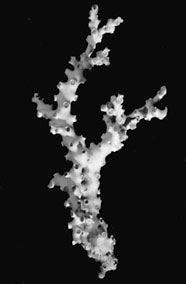
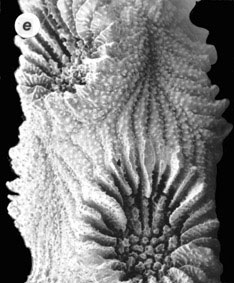
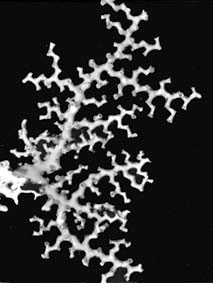
Left: Oculina virgosa: Skeleton of a colony collected from off North Cape, New Zealand (depth 40 m). Height of corallum 150 mm. From Cairns, 1995. Copyright © 1995 National Institute of Water & Atmospheric Research. Center: O. profunda: SEM of paratype branch fragment collected off California (depth 578 m). Branch about 3.5 mm thick (from Cairns, 1994). Right: Madrepora oculata: A flabellate colony collected from the Galapagos (depth 717 m). This is one of about a dozen coral species to have a cosmopolitan distribution. Height of colony 100 mm (from Cairns, 1991).
Discussion of Phylogenetic Relationships
No phylogenetic analysis has been performed on the genera within this subfamily. Characters used to distinguish genera rely on aspects of the columella and arrangement of pali.
References
Cairns, S. D. 1982. Antarctic and Subantarctic Scleractinia. Antarctic Research Series, 34: 74 pp.
Cairns, S. D. 1991. A revision of the ahermatypic Scleractinia of the Galápagos and Cocos Islands. Smithsonian Contributions to Zoology, 504: 32 pp.
Cairns, S. D. 1994. Scleractinia of the temperate North Pacific. Smithsonian Contributions to Zoology, 557: 150 pp.
Cairns, S. D. 1995. The marine fauna of New Zealand: Scleractinia (Cnidaria: Anthozoa). New Zealand Oceanographic Institute Memoir, 103: 210 pp.
Cairns, S. D. and Stanley, G. D. 1982. Ahermatypic coral banks: living and fossil counterparts. Proceedings of the Fourth International Coral Reef Symposium, Manila, 1: 611-618.
Chevalier, J.-P. 1987. Ordre des Scléractiniaires: Systematique. Pp. 679-753 In: Grassé (editor) Traité de Zoologie, 3(3) Masson, Paris.
Grygier, M. J. and S. D. Cairns. 1996. Suspected neoplasms in deep-sea corals reinterpreted as galls caused by Petrarca madreporae n. sp. Diseases of Aquatic Organisms, 24: 61-69.
Reed, J. K. 1980. Distribution and structure of deep-water Oculina varicosa coral reefs off central eastern Florida. Bulletin of Marine Science, 30(3): 667-677.
Veron, J. E. N. 1995. Corals in Space and Time. 321 pp. UNSW Press, Sydney.
Wells, J. W. 1956. Scleractinia. Pp. F328-F444 In: Moore, R. C. (editor) Treatise on Invertebrate Paleontology, Part F: Coelenterata. University of Kansas Press, Lawrence.
Title Illustrations

| Scientific Name | Oculininae |
|---|---|
| Location | Rosalind Bank, Nicaragua, Caribbean (depth 162 m) |
| Comments | A flabellate colony showing sympodial branching pattern |
| Specimen Condition | Dead Specimen |
| Size | Height of colony 460 mm |
| Image Use |
 This media file is licensed under the Creative Commons Attribution-NonCommercial License - Version 3.0. This media file is licensed under the Creative Commons Attribution-NonCommercial License - Version 3.0.
|
| Copyright |
© 2002

|
About This Page
Creation of this page was supported by US National Science Foundation grants DEB95-21819 and DEB 99-78106 (in the program PEET - Partnerships to Enhance Expertise in Taxonomy) to Daphne G. Fautin, grant DEB99-78086 (in the program PEET) to Stephen D. Cairns, and grant OCE 00-03970 (in NOPP, the National Oceanographic Partnership Program) to D.G.F. and Robert W. Buddemeier.
Technical assistance was rendered by Adorian Ardelean.
The author welcomes the opportunity to identify specimens from this subfamily, and offers to incorporate them into the collection of the National Museum of Natural History, Smithsonian, unless their return is requested.

Smithsonian Institution, Washington, D. C., USA
Correspondence regarding this page should be directed to Stephen D. Cairns at
Page copyright © 2002
 Page: Tree of Life
Oculininae .
Authored by
Stephen D. Cairns.
The TEXT of this page is licensed under the
Creative Commons Attribution-NonCommercial License - Version 3.0. Note that images and other media
featured on this page are each governed by their own license, and they may or may not be available
for reuse. Click on an image or a media link to access the media data window, which provides the
relevant licensing information. For the general terms and conditions of ToL material reuse and
redistribution, please see the Tree of Life Copyright
Policies.
Page: Tree of Life
Oculininae .
Authored by
Stephen D. Cairns.
The TEXT of this page is licensed under the
Creative Commons Attribution-NonCommercial License - Version 3.0. Note that images and other media
featured on this page are each governed by their own license, and they may or may not be available
for reuse. Click on an image or a media link to access the media data window, which provides the
relevant licensing information. For the general terms and conditions of ToL material reuse and
redistribution, please see the Tree of Life Copyright
Policies.
- First online 28 October 2002
Citing this page:
Cairns, Stephen D. 2002. Oculininae . Version 28 October 2002. http://tolweb.org/Oculininae/19127/2002.10.28 in The Tree of Life Web Project, http://tolweb.org/





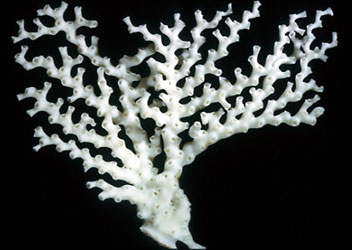
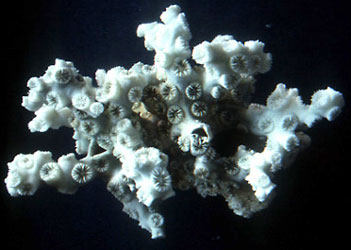




 Go to quick links
Go to quick search
Go to navigation for this section of the ToL site
Go to detailed links for the ToL site
Go to quick links
Go to quick search
Go to navigation for this section of the ToL site
Go to detailed links for the ToL site